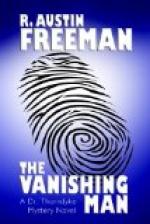“That is how the affair stands at present, and, should the missing man never reappear or should his body never be found, the question, as you see, which will be required to be settled is, ’What is the exact time and place, when and where, he was last known to be alive?’ As to the place, the importance of the issues involved in that question are obvious and we need not consider them. But the question of time has another kind of significance. Cases have occurred, as I pointed out in the lecture, in which proof of survivorship by less than a minute has secured succession to property. Now, the missing man was last seen alive at Mr. Hurst’s house at twenty minutes past five on the twenty-third of November. But he appears to have visited his brother’s house at Woodford, and, since nobody saw him at that house, it is at present uncertain whether he went there before or after calling on Mr. Hurst. If he went there first, then twenty minutes past five on the evening of the twenty-third is the latest moment at which he is known to have been alive; but if he went there after, there would have to be added to this time the shortest possible time in which he could travel from the one house to the other.
“But the question as to which house he visited first hinges on the scarab. If he was wearing the scarab when he arrived at Mr. Hurst’s house, it would be certain that he went there first; but if it was not then on his watch-chain, a probability would be established that he went first to Woodford. Thus, you see, a question which may conceivably become of the most vital moment in determining the succession of property turns on the observation or non-observation by this housemaid of an apparently trivial and insignificant fact.”
“Has the servant made any statement on the subject, sir?” I ventured to inquire.
“Apparently not,” replied Dr. Thorndyke; “at any rate, there is no reference to any such statement in the newspaper report, though, otherwise, the case is reported in great detail; indeed, the wealth of detail, including plans of the two houses, is quite remarkable and well worth noting as being in itself a fact of considerable interest.”
“In what respect, sir, is it of interest?” one of the students asked.
“Ah!” replied Dr. Thorndyke, “I think I must leave you to consider that question yourself. This is an untried case, and we mustn’t make free with the actions and motives of individuals.”
“Does the paper give any description of the missing man, sir?” I asked.
“Yes; quite an exhaustive description. Indeed, it is exhaustive to the verge of impropriety, considering that the man may possibly turn up alive and well at any moment. It seems that he has an old Pott’s fracture of the left ankle, a linear, longitudinal scar on each knee—origin not stated, but easily guessed at—and that he has tattooed on his chest in vermilion a very finely and distinctly executed representation of the symbolical Eye of Osiris—or Horus or Ra, as the different authorities have it. There certainly ought to be no difficulty in identifying the body. But we will hope that it won’t come to that.




